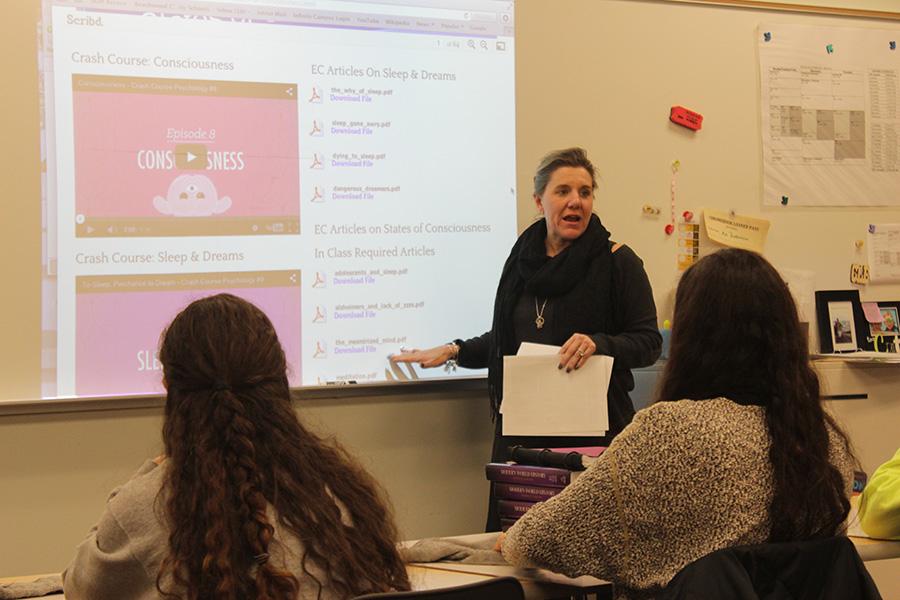District Adjusts to New Teacher Evaluation System
Beginning in the 2013-2014 school year, the Ohio Department of Education implemented a new system of teacher evaluations, created on the principle that teachers should be held accountable for student growth.
“One of the big things that [Beachwood is] focusing on this year is clearly stated objectives,” Beachwood Federation of Teachers Building Representative Pam Ogilvy said, “…not only that the teacher goes into the lesson with a certain objective, but that the students understand that objective.”
As part of this new system, 50% of teachers’ evaluations are determined by how much their students learn throughout the year, as determined by a new “value-added” model.
According to the Ohio Department of Education website, “Value-Added provides data on student growth on state assessments…[through] statistical methods to measure teachers’, schools’ and districts’ impact on the rate of student progress from year to year.”
The current contract between the Beachwood Board of Education and the Beachwood Federation of Teachers states that 4th-8th grade OAA scores from 2012-2013 are factored into the evaluations of all teachers in the district. Because students exceeded expected growth on the tests that year, the scores will positively impact the evaluations of all teachers in the district for a three-year period.
“It’s called shared attribution,” Ogilvy explained. “Nearly all the teachers in the district will have the same rating. So … if we’re all rated the same thing, we all thrive together or we all…sink together.” The similar ratings are due to the value-added component, and the differences come from individual teacher instruction.
Beachwood uses the Ohio Teacher Evaluation System (OTES) model. The district must follow state and federal guidelines, though certain parts of the system are left up to the discretion of the local school district.
BHS Principal Ed Klein explained that a committee of Beachwood teachers and administrators called the NEC [New Evaluation Committee] met over a two-year period to develop how the district would implement OTES.
The OTES rubric has four ratings for teachers: “ineffective,” “developing,” “skilled” and “accomplished.” However, it is difficult to achieve an “accomplished” rating.
Last year there were 18 teachers in the school district rated “accomplished,” 106 rated “skilled” and 5 rated “developing.” No teachers were rated “ineffective.”
“The teacher performance rubric is very thorough in explaining what is expected for teaching and learning,” said Linda LoGalbo, Beachwood’s OTES coordinator and Hilltop Principal. “However, the rubric is challenging to use since the expectation for a “skilled” teacher encompasses a wide range.”
In terms of instructional planning, the criteria for “skilled” are that “[t]he teacher makes clear and coherent connections with students’ prior knowledge and future learning—both explicitly to students and within the lesson,” LoGalbo said.
“Nearly every teacher in Beachwood is ‘skilled’ and we were told going in that the likelihood of us getting skilled…was kind of a foregone conclusion,” Ogilvy said.
At the beginning of this year, all teachers created a growth plan, and their plans for this year are supposed to be stepping stones to those goals. One of those goals, according to Ogilvy, had to be about formative assessments which are meant to help guide teaching.
“It’s not necessarily a quiz or a test,” she said. “It could be taking a minute in the middle of a period and figuring out if the kids understand what’s going on, and if they don’t, okay, I’ve got to revamp things and reteach.”
The OTES system also arranges for helping ‘ineffective’ or ‘skilled’ teachers to improve.
“If a teacher’s rating is ‘developing’, a collaborative growth plan is devised…with targeted goals and objectives for improvement,” LoGalbo said. “If a teacher’s rating is ‘Ineffective,’ an improvement plan is created with specific goals and objectives.”
The other 50% of a teacher’s rating comes from observations, which is no small task for the administrators. Klein and Assistant Principal Ryan Patti are responsible for evaluating over 50 staff members.
“We spend a lot of time going in and out of classrooms on an informal basis…and watching what’s going on [in the] hallways. I find out more from the informal than I do from scheduling an observation,” Klein said. “I know that there’s good things happening daily from our teachers.”
With the administrators stretched so thin having to observe every teacher, there is some debate as to whether this is the best means of evaluation.
“I think of the options given…it’s the best thing for Beachwood,” Ogilvy said. “[A]ccountability is a good thing, but I’m not sure that this particular system is the best way.”
In accordance to the new system, “accomplished” teachers are evaluated every three years while “skilled” teachers are evaluated semiannually. Besides allowing administrators to know how well teachers are performing, evaluations also provide valuable information as to where teachers should be placed.
Beachwood uses “the strengths to make sure that we are providing the best education that we can,” Klein said. “You put your people where they’re going to perform their best so that the organization…has the best opportunity.”
BHS students have different views about how their teachers should be evaluated.
“I think the criteria to evaluate teachers should be entirely different for every subject,” senior Daniel Stanescu said. “You can’t have an end all, be all criteria for all teachers because evaluating a math teacher the same way you would evaluate a technology teacher would [be problematic].”
“The teachers at BHS are extremely intelligent and have a lot to bring to each class they teach,” senior Casey Blum wrote in an email. “I also love that all of them are so passionate about what they teach.”













